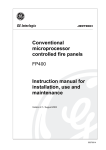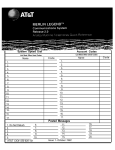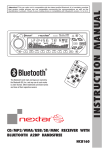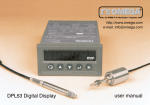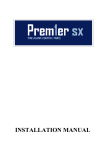Download AT&T Merlin User`s guide
Transcript
Lucent Technologies Bell Labs Innovations ® MERLIN PIus COMMUNICATIONS SYSTEM Release 2 User’s Guide 999-500-148 Issue 1 August 1988 © 1988 AT&T All Rights Reserved Printed in U.S.A. 999-500-148 Issue 1 August 1988 NOTICE The information in this document is subject to change without notice. Lucent Technologies assumes no responsibility for any errors that may appear in this document. MERLIN is a registered trademark of Lucent Technologies. To order copies of this document, call the Lucent Technologies Customer Information Center, 1-888-582-3688 and include the document number 999-500-148 with your order. Intellectual property related to this product (including trademarks) and registered to AT&T Corporation has been transferred to Lucent Technologies Incorporated, Any references within this text to American Telephone and Telegraph Corporation or AT&T should be interpreted as references to Lucent Technologies Incorporated. The exception is cross references to books published prior to December 31, 1996, which retain their original AT&T titles. Lucent Technologies – formed as a result of AT&T’s planned restructuring – designs, builds, and delivers a wide range of public and private networks, communication systems and software, consumer and business telephone systems, and microelectronic components. The world-renowned Bell Laboratories is the research and development arm for the company. Introduction Programming Ringing Options Features on a BIS-34D Voice Terminal with Display Placing Outside Calls Answering Your Calls Handling Calls with the Hold and Transfer Features Placing Intercom Calls Setting Up a Conference Call Using the Speakerphone and Speaker Using Privacy Features Paging Using a Template 2 3 4 6 10 14 16 17 18 19 20 21 1 About This Guide What the Lights Indicate This guide shows how to use various features of your MERLIN Plus system voice terminal, The MERLIN Plus System Manual provides complete information about system features and equipment. Lights next to the buttons on your voice terminal show the status of lines, features, and other people’s voice terminals. ● Next to a Line Button: Red = you get this line when you lift your handset, Steady green = this line is in use or on Exclusive Hold. Flashing green = a call is coming in on this line. Faster flashing green = someone else’s call on hold. Fastest flashing green = a call you’ve put on hold. ● Next to a Feature Button: Steady green = the feature is activated. Light off = the feature is deactivated. ● Next to a Direct Extension Dialing (DXD)/Call Forwarding (CF) Button: Green and red lights off = normal mode. Green light on = DXD mode. Red light o n = CF mode. Flashing red light = CF problem, call administrator. Flashing green light = DXD problem, call administrator. ● Next to a Remote Line Access (RLA) or System Answer (SA) Button: Steady green on = the feature is activated. Flashing green = problem with feature, call administrator. ● Next to an Auto Intercom Button: Steady green = the voice terminal is busy or the person is using Do Not Disturb. Flashing green = an intercom call is coming in to you from this voice terminal. Programming The procedures in this guide that show you how to program features onto buttons use the following symbols: • T P → (It rings while you’re programming.) Touch the button to which you’re assigning the feature. Button ■ ■ ■ ■ Slide the T/P switch to P to put your voice terminal in programming mode, ■ ■ ■ ■ ■ ■ ■ ■ Dial a number, such as a feature code or an outside telephone number. Code T • P ← Slide the T/P switch to the center position to return to regular call-handling mode. 2 Decide if incoming calls should ring at your voice terminal, how the ring should sound, and how loud it should be. Ringing Options You can set your voice terminal so that incoming calls ring right away, after a delay of two rings, or not at all. Use the delayed ring option if you answer calls for someone else when they’re not available. Use the no ring option if someone else normally answers your incoming calls. Volume Control To make the sound of the ringer louder, slide the volume control lever on the bottom left side of the voice terminal up (HI). To make it softer, slide the lever down (LO). Personalized Ringing You can choose from among eight ringing patterns. To select one, enter programming mode and touch Speakerphone (or Speaker) repeatedly until you hear the ringing pattern you prefer. To program: Touch each line button, then dial the code for the ringing option you prefer: The codes are *35 (no ring), *36 (delayed ring), and *37 (immediate ring). 3 7 6 8 5 4 3 9 2 1 10 14 11 12 13 1 Adjust the ringer volume of your voice terminal’s speaker with the volume control. 2 Use the dial pad to place calls. In programming mode, use it to enter codes and data. 3 Use Conference, Drop, Transfer, and Hold for efficient call handling. 4 Test your voice terminal and program its features by sliding the T/P switch to T (Test) or P (Program), 5 Use line buttons to call people who aren’t connected to your system. 6 Use the display buttons to operate clock, calendar, timer, and alarm functions. 7 Adjust the contrast on the display. 8 Use the information on the display as you handle calls and messages and program your voice terminal. * 9 Tailor your voice terminal to meet your individual needs by programming available buttons with custom features. 10 Adjust the volume of the speakerphone. 11 The Speakerphone feature allows you to have a phone conversation without using the handset. The Speakerphone light indicates when the feature is activated. 12 Touching the Microphone button while you’re on a call enables you to have a private side conversation with someone in your office without the caller overhearing it. The Microphone light indicates when the feature is activated. 13 HFAI enables you to answer intercom calls hands free. The HFAI light indicates when the feature is activated. 14 If the Message light is on, call the attendant for your messages. The BIS-34D is the largest of the MERLIN Plus system voice terminals. Other models have buttons, but the features they have are located in the same positions as on the BIS-34D shown above. 5 You can assign telephone numbers to buttons or codes for quick dialing of outside calls. Using a special password, you can also use company lines to make outside calls from a remote location. Outside Auto Dial You can program telephone numbers onto buttons for one-touch dialing. To program: Label a button and follow the steps below. T • P Main Office → ■ ■ ■ ■ ■■■ ■■■ ■■■ ■■■ ✱ 90 ■ ■ ■ ■ ■ ■ ■ ■ T • To place a call: 1 Touch the Outside Auto Dial button. 2 If someone answers, begin speaking or lift your handset. If no answer, touch Speakerphone (or Speaker) to disconnect the call. P ← tel. no. Personal Speed Dial You can assign codes #01 through #24 to telephone numbers or account numbers you dial often. To program Personal Speed Dial codes: T • P → ■ ■ ■ ■ ■ ■ ■ ■ ■ ■ ■ ■ #01-#24 ■ ■ ■ ■ ■ ■ ■ ■ ■ ■ ■ ■ ✱ 90 ■ ■ ■ ■ ■ ■ ■ ■ ■ ■ ■ ■ tel. no. T • P ← To use Personal Speed Dial: 1 Dial the pound sign and code for your model voice terminal: – 22-Button Voice Terminal: Dial the pound sign and code (#01 through #12). – 5- and 10-Button Voice Terminals: Dial the pound sign and code (#01 through #24). 6 System Speed Dial Your administrator may assign System Speed Dial codes #60 through #89 and #900 through #999 to telephone numbers that people in your system call often, such as vendors or clients. You can program any of these codes on buttons for one-touch dialing. Ask your administrator for a list of System Speed Dial codes. To place a call: 1 If you have a button programmed with this code, touch the button. If not, dial the pound sign and code (#60 through #89 and #900 through #999). To program a System Sped Dial button: Label a button and follow these steps: T • P → Main Office ■■■ ■■■ ■■■ ■■■ ✱ 95 ■ ■ ■ ■ ■ ■ ■ ■ ■ ■ ■ ■ T • P ← 60-89 900-999 Last Number Dial You can program a button for one-touch redialing of the last number you called. To program: Label a button and follow these steps: T • P → Last No. ■ ■ ■ ■ ■ ■ ■ ■ ■ ■ ■ ■ ✱ 72 T • To use Last Number Dial: 1 Touch Last Number. 2 If someone answers, begin to speak or lift your handset. If no answer, touch Speakerphone (or Speaker) to disconnect. P ← 7 Saved Number Dial You can program a button to redial a telephone number that you've saved. To Program: Label a button and follow these steps: T • P → Saved Number ■ ■ ■ ■ ■ ■ ■ ■ ■ ■ ■ ■ ✱ 74 T • P To use Saved Number Dial: 1 Before disconnecting, touch Saved Number. 2 To redial the call, touch Saved Number. 3 If someone answers, begin to speak or lift your handset. If not, touch Speakerphone (or Speaker) to disconnect. ← Busy Buster You can program a button to have the system redial a busy telephone number automatically and signal you if the call goes through, if this feature has been administered on your system. When activated, Busy Buster will redial the busy number up to 15 times at 30 second intervals. To program Label a button and follow these steps: T • P → Busy Buster ■ ■ ■ ■ ■ ■ ■ ■ ■ ■ ■ ■ ✱ 31 T • P ← To use Busy Buster: 1 Before you disconnect, touch Busy Buster. 2 When you hear ringing, the signal that the call has gone through, touch Speakerphone (or Speaker) or lift your handset. IMPORTANT: Answer returning Busy Buster calls promptly when your voice terminal alerts you. Otherwise, the called party may become confused by the silence caused by the delay and hang up. To turn off Busy Buster: 1 Touch Busy Buster. 8 Remote Line Access (RLA) When the system is in the RLA mode you can call in from a remote location and enter a password to gain access to one of the system’s outside lines. To program: Label a button with a green light and follow these steps: T • P → PLA ■ ■ ■ ■ ■ ■ ■ ■ ■ ■ ■ ■ ✱ 84 T • P ← To use RLA: 1 If the system is in RLA mode, go to the next step. If the system is in either CF or DXD mode, after the introductory message, dial *#*. 2 From a remote location, dial the telephone number of a line in the RLA incoming line group. 3 When requested, enter the 5-digit password. 4 When requested, enter a line number between 1 and 8 of the outside line you want to make your call on. 5 Dial the telephone number you are calling plus a pound sign. 6 Complete your call as usual. 9 You can answer your calls at your voice terminal or at another voice terminal. Answering Calls at Your Voice Terminal You can answer outside calls by activating the speakerphone or picking up the handset. To answer a call: 1 Touch Speakerphone or lift your handset. Answering Intercom Calls Automatically If your voice terminal has the Hands-Free-Answer-onIntercom (HFAI) feature or is connected to a Hands-Free Unit (HFU), you can have your speakerphone go on automatically whenever you receive an intercom call. TO do this with an HFU, you must program an Auto Answer-Intercom button. To program: Label a button with lights and follow these steps: T • P → Auto Ans.Intercom ■ ■ ■ ■ ■ ■ ■ ■ ■ ■ ■ ■ ✱ 70 T • To activate the automatic answer feature: 1 Touch HFAI or Auto Answer-Intercom. The light next to the button goes on. To deactivate the automatic answer feature: 1 Touch HFAI or Auto Answer-Intercom. The light next to the button goes off. P ← 10 Forwarding Calls You can use the Call Forwarding (CF) feature to have all calls that come into designated lines forwarded to another number. Call Forwarding can be activated from any voice terminal with a CF/DXD button. To program: To activate Call Forwarding: 1 Touch CF/DXD until only the red light is on. To cancel Call Forwarding: 1 Touch CF/DXD until both the red and green lights are off. Label a button with lights and follow these steps: T • P → CF/DXD ■ ■ ■ ■ ■ ■ ■ ■ ■ ■ ■ ■ ✱ 83 T • P ← Directing Calls to Extensions Direct Extension Dialing (DXD) directs incoming calls to requested extensions. Callers hear a voice message that requests the desired extension number. The call is then transferred to the requested extension. This feature can be activated from any voice terminal with a CF/DXD button. To activate Direct Extension Dialing 1 Touch CF/DXD until only the green light is on. To deactivate Direct Extension Dialing 1 Touch CF/DXD until both the green light and the red light are off. To program Label a button with lights (if you already have a CF button, you use the same one for DXD) and follow these steps: T • P → CF/DXD ■ ■ ■ ■ ■ ■ ■ ■ ■ ■ ■ ■ ✱ 83 T • P ← 11 Automatic Answering of Calls You can use System Answer to answer calls automatically and place them on hold until someone is available to handle them. System Answer can only be activated from either the attendant console or the alternate attendant console. Label a button with a green light and follow these steps: • P → 1 Touch System Answer. The green light comes on. To deactivate System Answer. 1 Touch System Answer. To program: T To activate System Answer: System Answer ■ ■ ■ ■ ■ ■ ■ ■ ■ ■ ■ ■ ✱ 58 T • The green light goes off. P ← 12 Using Call Pickup You can use Call Pickup to answer a call coming into someone else’s voice terminal. There are two ways to pick up calls ringing on another voice terminal: You can touch a Call Pickup button then dial the intercom number of the ringing voice terminal or, if you regularly handle calls for someone else, you can program an individual Call Pickup button, so that you can pick up calls on that voice terminal with one touch. To use a general Call Pickup Button: 1 Touch Speakerphone or lift your handset. 2 Touch Call Pickup. 3 Dial the intercom number. To use an indvidual Call Pickup Button: 1 Touch Speakerphone or lift your handset. 2 Touch Call Pickup. To program a general Call Pickup button: Label a button and follow these steps: T • P → Call Pickup ■ ■ ■ ■ ■ ■ ■ ■ ✱ 85 ■ ■ ■ ■ T • P ← To program an individual Call Pickup button: T • P → Call Pickup 18 ■ ■ ■ ■ ■ ■ ■ ■ ■ ■ ■ ■ ✱ 85 ■ ■ ■ ■ ■ ■ ■ ■ ■ ■ ■ ■ Icom No. T • P ← 13 You use fixed buttons on your voice terminal to put calls on hold and transfer them to other people. Putting Calls on HoId After you put a call on hold, you can hang up your handset or touch a line button to take another call. When you put a call on hold, a green light flashes next to the line button. Your voice terminal beeps every 60 seconds to remind you of the held call. You can also put a call on Exclusive Hold so no one at another voice terminal can pick up the call. To program an Exclusive Hold button: Label the button Exclusive Hold and follow these steps: T • P → Exclusive Hold ■■■ ■■■ ■■■ ■■■ ✱7 T • P To put a call on hold, then retrieve it: 1 To put a call on hold, touch Hold. 2 To take a call off hold, touch the line button of the held call. To put a call on Exclusive Hold, then retrieve it: 1 To put a call on Exclusive Hold, touch Exclusive Hold. 2 Take the call off Exclusive Hold by touching Speakerphone (or Speaker) or by touching the line button of the held call. This can only be done from the voice terminal that put the call on Exclusive Hold. ← 14 Transferring Calls You use a fixed button on your voice terminal to transfer outside calls to other voice terminals. If the person to whom you transfer the call doesn’t answer within a preset number of rings, the call rings at your voice terminal again. To transfer a call: 1 Touch Transfer. 2 Touch the Auto Intercom button or dial the intercom number for the person. To place one-touch transfer: 1 With the call in progress, touch the Auto Intercom button of the person to whom you want to transfer the call. 2 When you hear a beep, announce the call, if appropriate, and advise the person which line the call is on. 3 Hang up. 15 You can call anyone in the MERLIN Plus system by dialing his or her intercom number or by touching a button you’ve programmed with that number. You can also enable your voice terminal so that you can hear voice announcements through your voice terminal speaker. To program an Auto Intercom button: T • P → John 12 ■ ■ ■ ■ 1 Touch Intercom. 2 Touch Speakerphone or lift your handset. 3 Dial the 2-digit intercom number of the voice terminal you want to call. 4 When you hear a beep, begin speaking. If you hear a series of beeps, wait for the person to answer. To place an intercom call with one touch: Label a button and follow these steps: ■■■ ■■■ ■■■ ■■■ ✱ 91 To place an intercom call: ■ ■ ■ ■ ■ ■ ■ ■ T • P ← Icom No. 1 Touch the Auto Intercom button for the voice terminal you want to call. 2 Begin speaking or lift your handset and begin speaking. To enable/disable voice announcements: T • P → Intercom ■ ■ ■ ■ ■ ■ ■ ■ ■ ■ ■ ■ ✱ 38 or ✱ 39 T • P ← 16 You can set up a conference call that includes up to two people in the MERLIN Plus system, two people-from outside the system, and yourself. People connected to the MERLIN Plus system can bridge onto an outside line that is active on a conference call. To set up a conference call: 1 To set up a call when one of the people is already on the line, touch Conference. 2 Touch an outside line button. 3 Dial the outside telephone number of the person. you’re adding to the call. 4 Take the appropriate action: – If the person answers, begin the conversation. – If the person doesn’t answer, touch Drop, and repeat steps 1 through 3 to add another person. To leave and reenter a conference call: 1 Touch Hold to remove yourself from the call. 2 To rejoin the call, touch Speakerphone or lift the handset and touch one of the line buttons associated with the call. 17 Using the Speakerphone If you have a speakerphone, you can dial and conduct a call without lifting your handset. You can activate the speakerphone before you place the call or at any time during the call. The lights next to Speakerphone and Microphone go on whenever the speakerphone is on. To turn the speakerphone on or off: 1 Touch Speakerphone. Green light on = Green light off = Speakerphone on Speakerphone off Using the Speaker If you don’t have a speakerphone, you can use your voice terminal speaker to monitor calls as you place them or while you’re on hold. You don’t need to lift your handset until you’re ready to speak. To listen while you place a call: 1 Touch Speaker, then dial the call. 2 If someone answers, lift your handset. If not, touch Speaker to disconnect the call. To monitor while you’re waiting on hold: 1 When you’re put on hold, touch Speaker and hang up. 2 When you’re taken off hold, lift your handset. To let others hear an in-progress call: 1 Touch Speaker without hanging up. 18 Program privacy features on buttons with lights. Privacy The Privacy feature prevents people who share your lines from bridging onto your conversation. To program: Label a button with lights and follow these steps: T • P → Privacy ■ ■ ■ ■ ■ ■ ■ ■ ■ ■ ■ ■ ✱ 72 T • P ← To turn Privacy on: 1 Touch Privacy. The green light comes on. To turn Privacy off: 1 Touch Privacy. The green light goes off. Do Not Disturb The Do Not Disturb feature prevents calls from ringing at your voice terminal, although you can still place and receive calls. To program: Label a button with lights and follow these steps: T • P → Do Not Disturb ■ ■ ■ ■ ■ ■ ■ ■ ■ ■ ■ ■ ✱ 71 T • P ← To turn Do Not Disturb on: 1 Touch Do Not Disturb. The green light comes on. To turn Do Not Disturb off: 1 Touch Do Not Disturb. The green light goes off. 19 With the Page features, you can make announcements to people through your voice terminal. Group Page If your administrator has set up paging groups, you can make announcements to members of a particular group, Ask your administrator for the group codes. To make an announcement to a paging group: 1 Touch Intercom. 2 Touch Speakerphone (or Speaker) or lift your handset and dial the code for the group. 3 At the beep, make your announcement through your handset. Loudspeaker Page Connect a loudspeaker paging system to your control unit in either of two ways. Connect it to a line jack, touch the line button then follow the directions provided with the unit to page someone, Connect it to the page jack and follow these instructions to make announcements. To program a Loudspeaker Page button (page jack connection): Label the button and follow these steps: T • P → Ldsp. Page ■ ■ ■ ■ ■ ■ ■ ■ ■ ■ ■ ■ ✱ 91 ■ ■ ■ ■ ■ ■ ■ ■ 6 ■ ■ ■ ■ T • P ← To make an announcement with a page jack . connection: 1 Touch Loudspeaker Page. 2 When you hear a beep, touch Speakerphone or lift your handset and make your announcement. or 1 2 3 4 Touch Intercom. Touch Speakerphone or lift your handset. Dial 6. When you hear a beep, make your announcement. 20 If the system administrator has assigned one of three voice terminal templates to your voice terminal, you already have special features programmed onto buttons, The special features for each template are shown on the following pages. Refer to the Merlin Plus System Manual for information on how to use these features. KEY AI BB DND DXD/CF LND CP10 PAGE 1 PAGE ALL ROVRD SND 1 SND 2 = = = = = = = = = = = Auto Intercom Busy Buster Do Not Disturb Direct Extension Dialing/Call Forwarding Last Number Dial Call Pickup 10 Page Group 1 Page All Ring Override Save Number Dial 1 Save Number Dial 2 21 Dialer Template 34-Button 22-Button 10-Button ❑ ❑ Line D ❑ ❑ Line H ❑ ❑ ❑ ❑ ❑ ❑ Line C ❑ ❑ Line G ❑ ❑ ❑ ❑ ❑ Line B ❑ ❑ ❑ Line F ❑ ❑ ❑ ❑ ❑ ❑ ❑ ❑ Line E ❑ ❑ ❑ ❑ ❑ ❑ BB ❑ ❑ ❑ ❑ ❑ ❑ ❑ ❑ ❑ ❑ ❑ ❑ ❑ ❑ ❑ ❑ ❑ ❑ ❑ ❑ Line A ❑ Intercom ❑ Conference Drop ❑ ❑ Transfer Hold ❑ ❑ ❑ ❑ Al10 ❑ ❑ ❑ ❑ SND ❑ ❑ ❑ ❑ LND ❑ ❑ Assign to Intercom Number(s): (See Note) NOTE: If there are fewer than eight outside lines on a voice terminal, then those buttons wiII be blank on the template and on the target voice terminal. For example, if your system has four outside lines (Lines A through D), then the template will have four blank buttons and Busy Buster in the second column above the dial pad. 22 Feature Template 34-Button 22-Button 10-Button ❑ ❑ ROVRD ❑ ❑ Line D ❑ ❑ Line H ❑ ❑ ❑ ❑ Line C ❑ ❑ Line G ❑ Privacy ❑ ❑ ❑ ❑ ❑ Line B ❑ ❑ Line F ❑ ❑ ❑ ❑ ❑ Line A ❑ ❑ ❑ Line E ❑ ❑ ❑ ❑ ❑ ❑ Intercom ❑ ❑ BB ❑ ❑ ❑ ❑ ❑ ❑ ❑ ❑ ❑ ❑ ❑ ❑ ❑ Page 1 ❑ ❑ ❑ ❑ Page All ❑ ❑ ❑ ❑ ❑ Al10 ❑ ❑ ❑ ❑ SND1 ❑ ❑ SND2 ❑ ❑ LND ❑ ❑ DXD/CF Conference Drop ❑ ❑ (See Note) Transfer Hold ❑ ❑ DND Assign to Intercom Number(s): NOTE: If there are fewer than eight outside Iines on a voice terminal, then those buttons wiII be blank on the template and on the target voice terminal. For example, if your system has four outside Iines (Lines A through D), then the template wiII have four blank buttons and Busy Buster In the second column above the dial pad. 23 Receptionist/Secretary Template 34-Button 22-Button 10-Button Assign to Intercom Number(s): ❑ ❑ Line D ❑ ❑ Line H ❑ ❑ Al19 ❑ ❑ Al29 ❑ ❑ Line C ❑ ❑ Line G ❑ ❑ Al18 ❑ ❑ Al28 ❑ ❑ Line B ❑ ❑ Line F ❑ ❑ Al17 ❑ ❑ Al27 ❑ Line A ❑ ❑ ❑ Line E ❑ ❑ Al16 ❑ ❑ Al26 ❑ Intercom ❑ ❑ ❑ BB ❑ ❑ Al15 ❑ ❑ Al25 ❑ ❑ Al14 ❑ ❑ Al24 ❑ ❑ Al13 ❑ ❑ Al23 ❑ ❑ Al12 ❑ ❑ Al22 ❑ ❑ Al11 ❑ ❑ Al21 ❑ ❑ Al10 ❑ ❑ Al20 ❑ ❑ SND ❑ ❑ CP10 ❑ ❑ LND ❑ ❑ Page All Conference Drop ❑ ❑ Transfer Hold ❑ ❑ NOTE: If there are fewer than eight outside lines on a voice terminal, then those buttons will be blank on the template and on the target voice terminal. For example, If your system has four outside Iines (Lines A through D), then the template wiII have four blank buttons and Busy Buster In the second column above the dial pad. 24






























